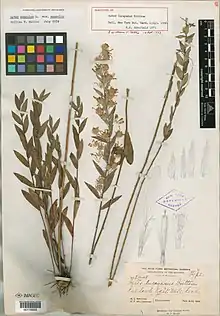Symphyotrichum lucayanum
Symphyotrichum lucayanum (formerly Aster lucayanus) is a species of flowering plant of the aster family (Asteraceae) endemic to the North American island of Grand Bahama.[4]
| Symphyotrichum lucayanum | |
|---|---|
 | |
| Holotype of Aster lucayanus stored in the NYBG.[1] | |
| Scientific classification | |
| Kingdom: | Plantae |
| Clade: | Tracheophytes |
| Clade: | Angiosperms |
| Clade: | Eudicots |
| Clade: | Asterids |
| Order: | Asterales |
| Family: | Asteraceae |
| Genus: | Symphyotrichum |
| Species: | S. lucayanum |
| Binomial name | |
| Symphyotrichum lucayanum | |
| Synonyms[3] | |
| |
Commonly known as pineland aster, it is a perennial, herbaceous plant that may reach 50 centimeters (20 inches) high. As composite flowers, each flower head has many tiny florets put together into what appear as one, as do all plants in the family Asteraceae. Symphyotrichum lucayanum has purple ray florets.[4]
The holotype for the basionym Aster lucayanus was collected 5 February 1905 at Pinelands, Eight Mile Rocks, Great Bahama.[5] It is stored in the New York Botanical Garden Steere Herbarium.[1]
References
- Ramirez, J.; Tulig, M.; Watson, K.; Thiers, B. (2021). "Occurrence 5 February 1905 - Aster lucayanus Britt. - Collected in Bahamas - Holotype". The New York Botanical Garden Herbarium (NY). Version 1.30. The New York Botanical Garden. Occurrence dataset https://doi.org/10.15468/6e8nje. Retrieved 31 January 2021 – via GBIF.org.
- Freid, E.H. (2019). "Symphyotrichum lucayanum". The IUCN Red List of Threatened Species 2019: e.T137682802A137682944. International Union for Conservation of Nature and Natural Resources. ISSN 2307-8235. Retrieved 31 January 2021.
- POWO (2019). "Symphyotrichum lucayanum (Britton) G.L.Nesom". Plants of the World Online (powo.science.kew.org). Royal Botanic Gardens, Kew. Retrieved 31 January 2021.
- Anonymous (n.d.). "Symphyotrichum lucayanum". Leon Levy Native Plant Preserve (www.levypreserve.org). Nassau, Bahamas: Bahamas National Trust. Retrieved 31 January 2021.
- Britton, N.L. (1906). "Contributions to the flora of the Bahama Islands III". Bulletin of the New York Botanical Garden. Lancaster, Pennsylvania: Published for the Garden by the New Era Printing Co. 4: 137–143. Retrieved 31 January 2021 – via Biodiversity Heritage Library.
This article is issued from Wikipedia. The text is licensed under Creative Commons - Attribution - Sharealike. Additional terms may apply for the media files.
